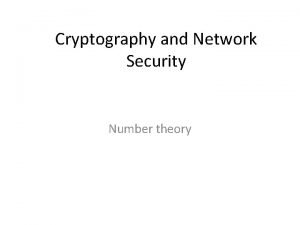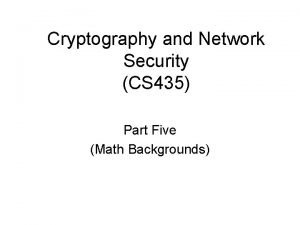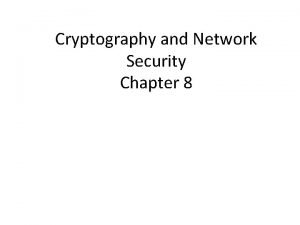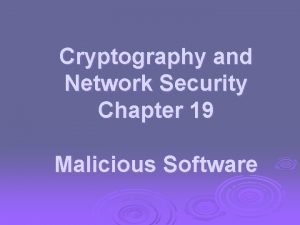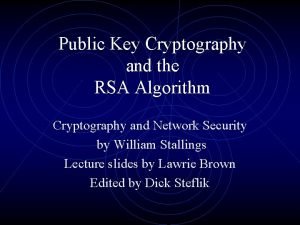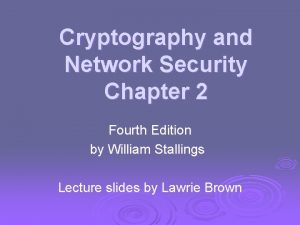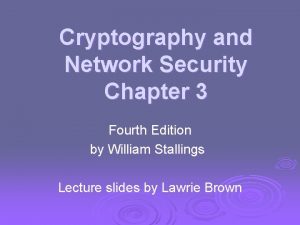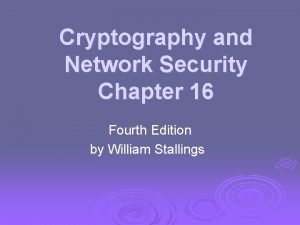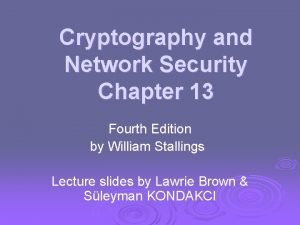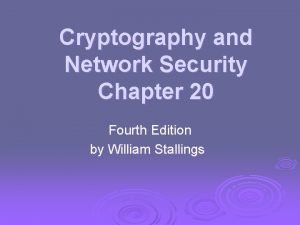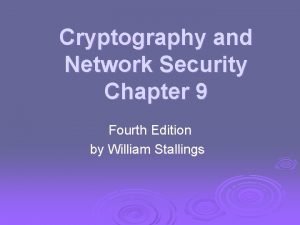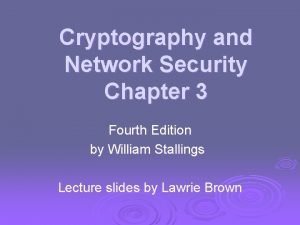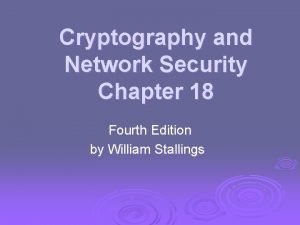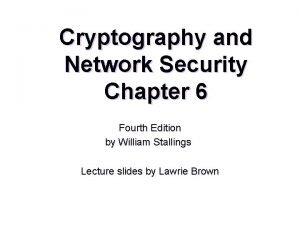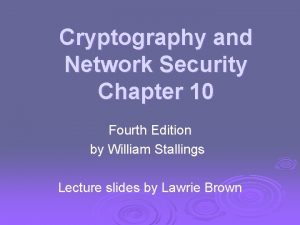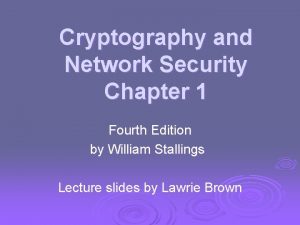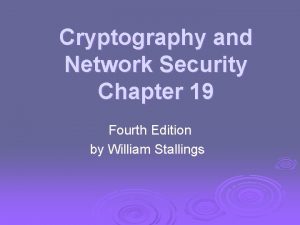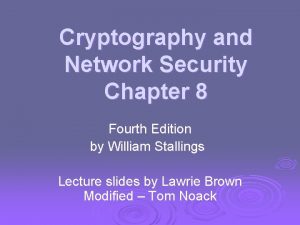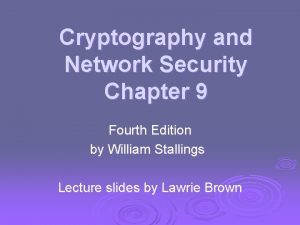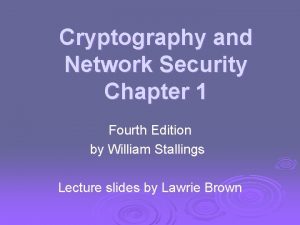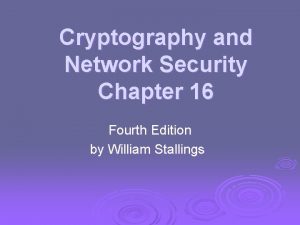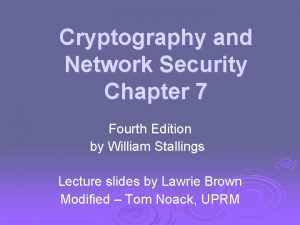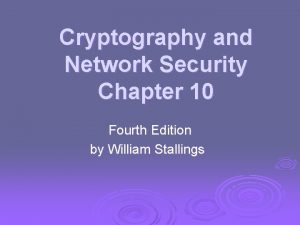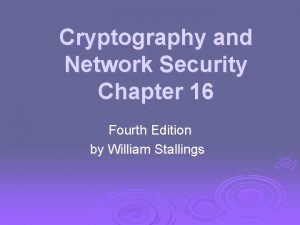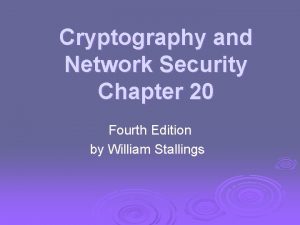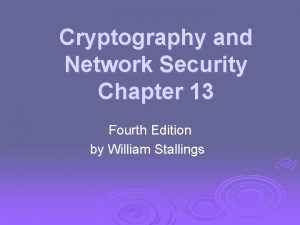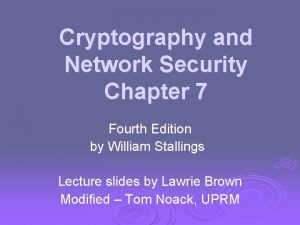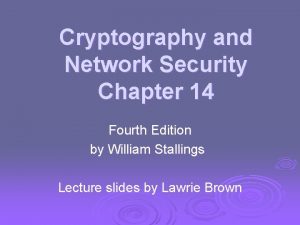Cryptography and Network Security Chapter 1 Fourth Edition
























- Slides: 24

Cryptography and Network Security Chapter 1 Fourth Edition by William Stallings After Lawrie Brown

Background Information Security requirements have changed in recent times Ø traditionally provided by physical and administrative mechanisms Ø computer use requires automated tools to protect files and other stored information Ø use of networks and communications links requires measures to protect data during transmission Ø

Definitions Computer Security - generic name for the collection of tools designed to protect data and to thwart hackers Ø Network Security - measures to protect data during their transmission Ø Internet Security - measures to protect data during their transmission over a collection of interconnected networks Ø

Aspects of Security Ø Security Attack: Any action that compromises the security of information. Ø Security Mechanism: A mechanism that is designed to detect, prevent, or recover from a security attack. Ø Security Service: A service that enhances the security of data processing systems and information transfers. A security service makes use of one or more security mechanisms.

Security Attacks

Security Attacks Ø Interruption: This is an attack on availability Ø Interception: This is an attack on confidentiality Ø Modification: This is an attack on integrity Ø Fabrication: This is an attack on authenticity

Security Goals Confidentiality Integrity Availability

Security Attack any action that compromises the security of information owned by an organization Ø information security is about how to prevent attacks, or failing that, to detect attacks on information-based systems Ø often threat & attack used to mean same thing Ø have a wide range of attacks Ø can focus of generic types of attacks Ø l l passive active

Passive Attacks

Active Attacks


Security Services Ø Confidentiality (privacy) Ø Authentication (who created or sent the data) Ø Integrity (has not been altered) Ø Non-repudiation (the order is final) Ø Access control (prevent misuse of resources) Ø Availability (permanence, non-erasure) l Denial of Service Attacks l Virus that deletes files

Security Service l l enhance security of data processing systems and information transfers of an organization intended to counter security attacks using one or more security mechanisms often replicates functions normally associated with physical documents • which, for example, have signatures, dates; need protection from disclosure, tampering, or destruction; be notarized or witnessed; be recorded or licensed

OSI Security Architecture Ø ITU-T X. 800 “Security Architecture for OSI” Ø defines a systematic way of defining and providing security requirements Ø for us it provides a useful, if abstract, overview of concepts we will study

Security Services Ø X. 800: “a service provided by a protocol layer of communicating open systems, which ensures adequate security of the systems or of data transfers” Ø RFC 2828: “a processing or communication service provided by a system to give a specific kind of protection to system resources”

Security Services (X. 800) Authentication - assurance that the communicating entity is the one claimed Ø Access Control - prevention of the unauthorized use of a resource Ø Data Confidentiality –protection of data from unauthorized disclosure Ø Data Integrity - assurance that data received is as sent by an authorized entity Ø Non-Repudiation - protection against denial by one of the parties in a communication Ø

Security Mechanism Ø feature designed to detect, prevent, or recover from a security attack Ø no single mechanism that will support all services required Ø however one particular element underlies many of the security mechanisms in use: l cryptographic techniques Ø hence our focus on this topic

Methods of Defence Ø Encryption Ø Software Controls (access limitations in a data base, in operating system protect each user from other users) Ø Hardware Controls (smartcard) Ø Policies (frequent changes of passwords) Ø Physical Controls

Security Mechanisms (X. 800) Ø specific security mechanisms: l encipherment, digital signatures, access controls, data integrity, authentication exchange, traffic padding, routing control, notarization Ø pervasive security mechanisms: l trusted functionality, security labels, event detection, security audit trails, security recovery

Model for Network Security

Model for Network Security Ø using this model requires us to: 1. 2. 3. 4. design a suitable algorithm for the security transformation generate the secret information (keys) used by the algorithm develop methods to distribute and share the secret information specify a protocol enabling the principals to use the transformation and secret information for a security service

Model for Network Access Security

Model for Network Access Security Ø using this model requires us to: 1. 2. Ø select appropriate gatekeeper functions to identify users implement security controls to ensure only authorised users access designated information or resources trusted computer systems may be useful to help implement this model

Summary Ø have considered: l definitions for: • computer, network, internet security Ø X. 800 standard Ø security attacks, services, mechanisms Ø models for network (access) security
 Cryptography and network security 6th edition
Cryptography and network security 6th edition Cryptography and network security 6th edition pdf
Cryptography and network security 6th edition pdf Cryptography and network security 4th edition
Cryptography and network security 4th edition Pearson cryptography and network security
Pearson cryptography and network security Wireless security in cryptography
Wireless security in cryptography Introduction to cryptography and network security
Introduction to cryptography and network security Number theory in cyber security
Number theory in cyber security Firewall in cryptography and network security
Firewall in cryptography and network security Authentication in cryptography and network security
Authentication in cryptography and network security Intruders in cryptography and network security
Intruders in cryptography and network security Primitive root in cryptography and network security
Primitive root in cryptography and network security Euler's theorem in cryptography and network security
Euler's theorem in cryptography and network security Fermat's theorem in cryptography and network security
Fermat's theorem in cryptography and network security Multiplicative inverse
Multiplicative inverse Digital signature in cryptography and network security
Digital signature in cryptography and network security Modular arithmetic in cryptography and network security
Modular arithmetic in cryptography and network security Pgp in cryptography and network security
Pgp in cryptography and network security Euler's theorem in cryptography and network security
Euler's theorem in cryptography and network security Malicious software in cryptography
Malicious software in cryptography Introduction to cryptography and network security
Introduction to cryptography and network security Rsa algorithm in cryptography and network security
Rsa algorithm in cryptography and network security Introduction to cryptography and network security
Introduction to cryptography and network security Expert systems: principles and programming, fourth edition
Expert systems: principles and programming, fourth edition Network security essentials 5th edition pdf
Network security essentials 5th edition pdf Network security essentials 5th edition
Network security essentials 5th edition












